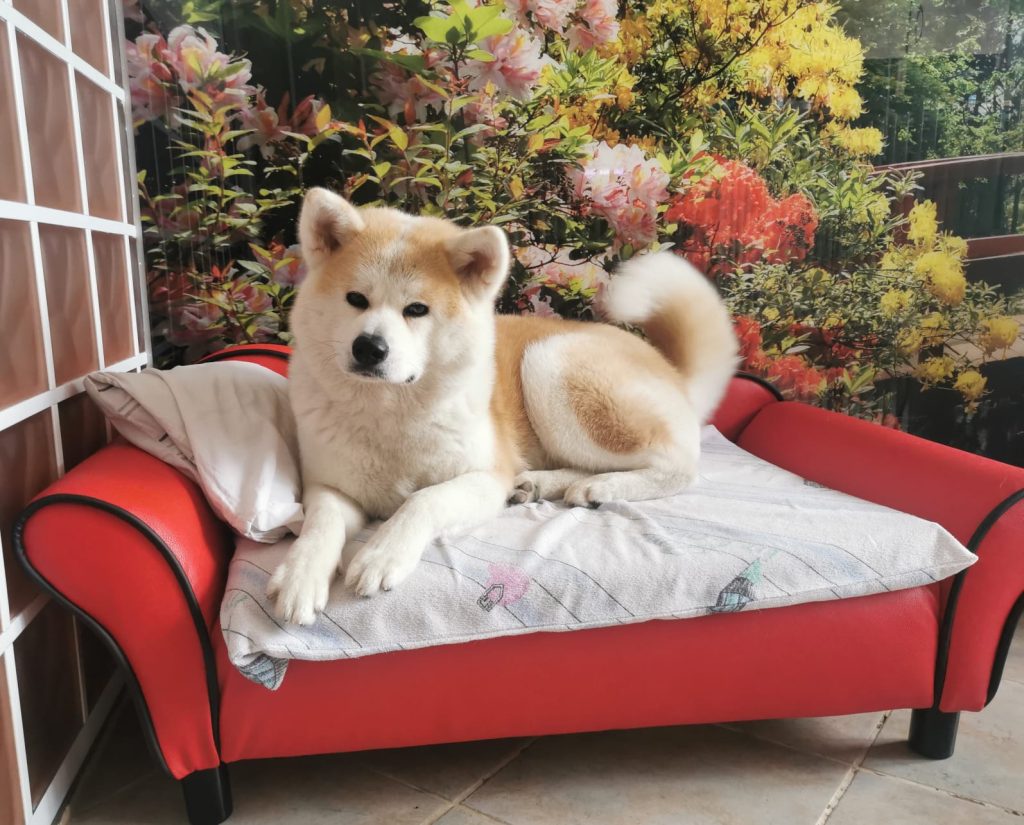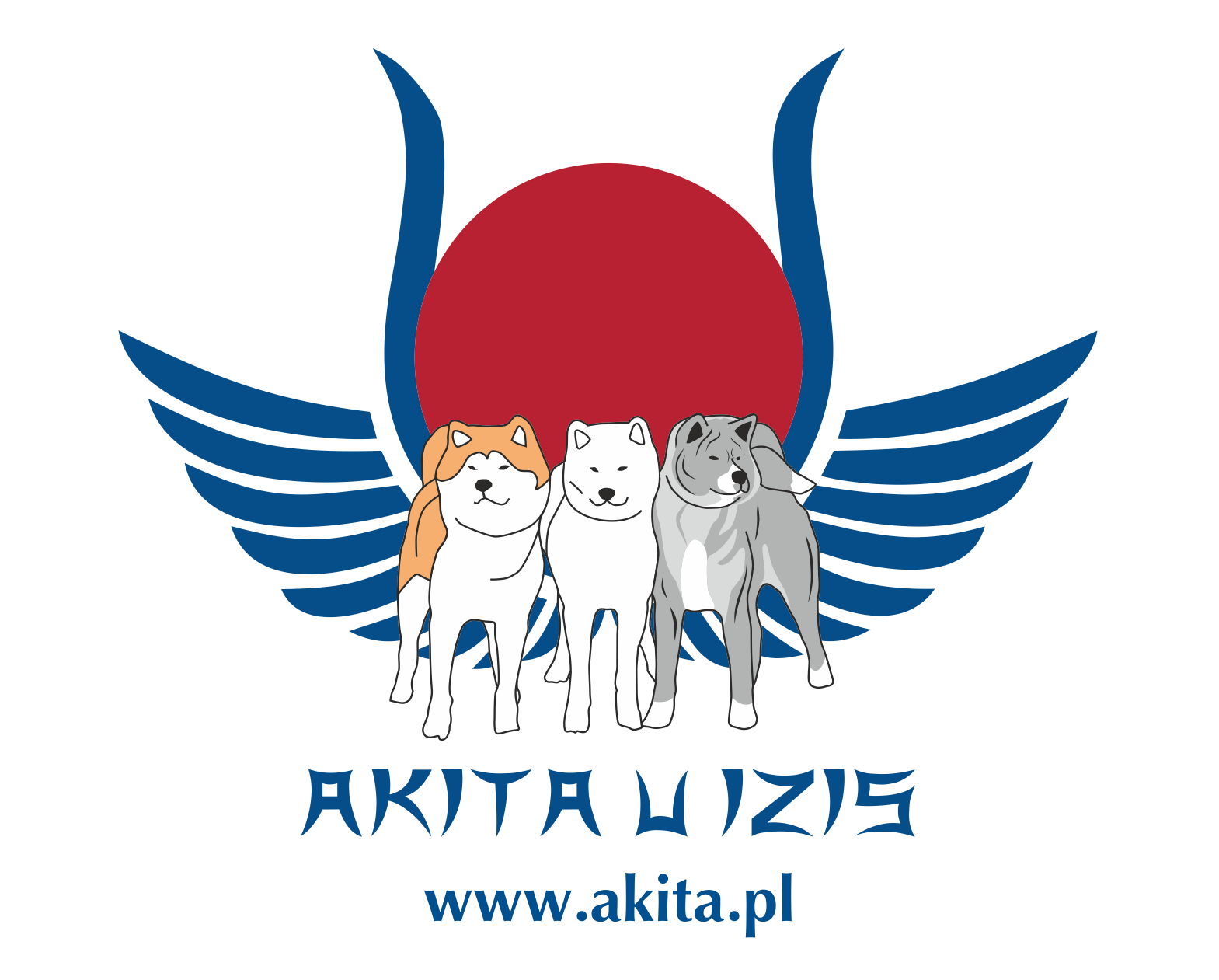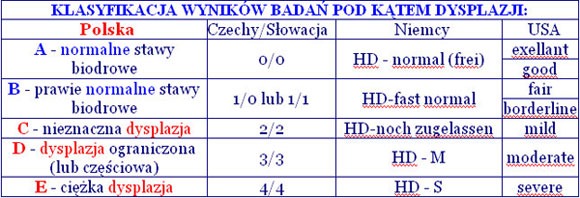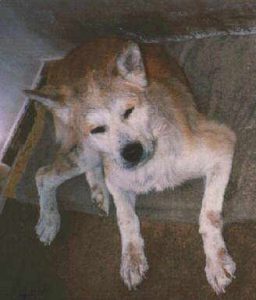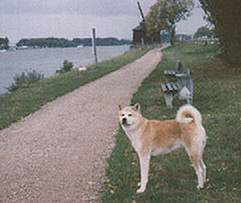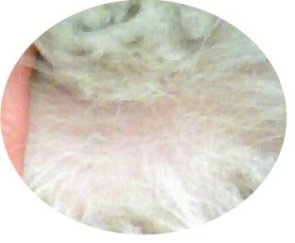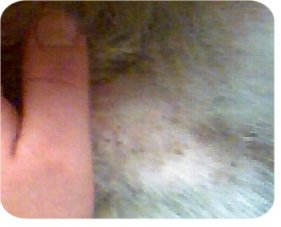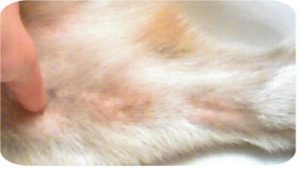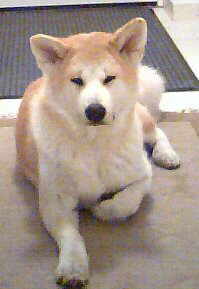DYSPLASIA – causes – what the breeder can do and what the owner should do!
Dysplasia, simply put, is a deformation of the hip joint. The acetabulum is so flat that it does not fully cover the head of the femur. Dysplasia most often affects dog breeds that grow very intensively during puppyhood.
Based on research, the Swedes determined the probability of dysplasia in puppies from various matings:
both parents are free from dysplasia: 24%- 37.5% (If all grandparents are free from dysplasia, the probability is only 8.7 %!)
one parent with dysplasia: 44.7% – 50%
both parents with dysplasia: 84.1% to even 93 %!
In the USA, the reliability of X-rays at different ages was examined: 12 months - 68.9 %, 18 months - 82.7 %, and 24 months - even 95.4 %. This means that it is possible that a 1-year-old dog with mild dysplasia may have healthy joints at the age of 2 (due to ongoing development). So if we have a dog of high value with slight dysplasia, we should not use it, but we should not withdraw it from breeding - let's repeat the tests at the age of 2 years.
The international rules for combating dysplasia in dogs are:
Pair dogs with normal hip joints;
Normal dogs should come from normal parents and grandparents;
Normal parents should produce 75% healthy offspring;
Partners with the highest % of born normal offspring (at least 75%) should be selected for mating;
For breeding, you should choose female dogs with perfectly shaped hip joints - better than those of their parents.
Of course, dysplasia also involves environmental factors, i.e. the influence of the environment:
poor conditions for raising puppies, overfeeding them, poor diet (lack of balanced food, which practically only ready-made food and appropriate supplements can provide to a large breed puppy). On the so-called Home-made food (which some people call table scraps - with a lot of spices and other things not recommended for a dog) will not raise a healthy large breed puppy (even if you bought it from a reputable breeder - from both parents free of dysplasia).
At this point, I appeal to you: if you cannot afford to properly feed a large dog (and especially in the first year the amounts are really significant), please do not buy a puppy and do not waste its health and life. Or postpone the purchase for a while and save to have financial reserves for the time of its growth, because once you buy a dog, you cannot postpone its proper feeding until later. Every bag of cheap food from the Supermarket or cheap Chapi or Pedigree you buy will take its revenge very quickly. If you save on good food (because the lady from the pet store recommended a cheap one), you will actually soon spend many times the saved amount on a veterinarian, and often without any effect. So if you cannot afford proper (unfortunately expensive) feeding of a large breed dog, please take a small dog from a shelter (its feeding will be much cheaper) and sometimes there are really beautiful gems there that really need a home! Why, driven only by the snobbish desire to show off to your friends, should you buy a beautiful, large dog that you cannot really afford to keep? You will waste it because you will regret buying high-quality food and vitamins that the breeder says and you will try to replace it with home-made food and an egg yolk or a bit of cottage cheese added from time to time. This dog, which would be wasted elsewhere at your place, would be a happy and healthy dog if well cared for and properly fed, and the breeder would not suffer to see you destroy a wonderfully promising dog, which he took care of from the day he was born until he was handed over to you.
Another cause of dysplasia is the inappropriate "use" of the puppy, i.e. lack of exercise or excess exercise - overloading the growing joints, as well as the type of exercise (e.g. climbing stairs to the 4th floor, running on slippery floors, where the paws spread apart without having a stable surface, a young puppy running on a bike, playing with too large and heavy dogs), poorly organized bed.
Puppies should receive high-quality food containing appropriate amounts of collagen substances, balanced in terms of minerals. Foods that cause obesity increase the risk of disease. If hip dysplasia is suspected, the only sure diagnosis can be made by X-ray. A reliable assessment of the joint can be made at the age of 12-18 months. The first symptoms of dysplasia can be observed at many 6 months. A dysplastic puppy may then limp and have difficulty jumping, climbing stairs and standing up. During the course of the disease, the joint becomes more damaged and the symptoms become more severe. So if for some reason you are concerned about your puppy's movement, you can check it. It is recommended that this inspection and a possible X-ray be performed by a veterinarian who is authorized to enter the dysplasia result in the pedigree, because only then can we be sure that he is not only a true professional but also a person with high ethics and that he will not deceive naive owners. a puppy, for example, for surgery on a healthy dog just to earn several hundred zlotys.
Attention! If, unfortunately, you have an X-ray taken by a veterinarian other than an authorized one, be sure to request the photo (the photo is your property and you paid for it) - and consult the diagnosis with an authorized veterinarian, so as not to unnecessarily cut up a healthy dog just because a poor veterinarian took a bad X-ray photo or read it incorrectly or, worse still, deliberately told us that we had a sick dog just to earn a few hundred zlotys.) If the doctor refuses to provide you with the photos and insists on surgery, I advise you to stay away from such clinics. Because if you don't have a photo, you will never prove to him that he not only cheated you out of a large sum of money, but what's worse, he unnecessarily exposed your dog to enormous pain and mutilation, which without his intervention would have been healthy until the end of its days - and will remain crippled forever. result of unnecessary surgery.
For example, trimming the adductors does not change the impairment of the hip joints (if it actually exists) and only temporarily reduces the pain. However, this procedure completely prevents the placement of endoprostheses in the future. International veterinary recommendations regarding the resection of femoral heads (in dogs with a target weight above 20 kg) clearly state: "absolutely not recommended!" Such thoughtless resection in a large breed dog, which is in the phase of intensive growth, may result in impairment of the second acetabulum (previously healthy) and deformation of the femur.
* Only photos of adult dogs taken for the purpose of entering the dysplasia result in the pedigree (by an authorized doctor) must remain in the clinic and are archived there (this is a requirement to obtain an entry in the pedigree). The remaining photos are always the property of the dog owner who pays for them.
ANDJewish Bach-Żelewska
* * *
ATTENTION! the following two articles were placed here with the consent of: Marzena Kaca-Bibrich (original source: www.z-palacu-cesarza.j.com.pl)
Dr. vet. med. Stefan Jung (translation: W.Ziemecki, consultation: dr.hab J.Siembieda)
"Does nutrition influence joint diseases?"
Degenerative joint diseases such as dysplasia and osteoporosis are not uncommon in dogs. Despite the dog's outstanding predispositions, factors related to the dog's upbringing and nutrition may influence the occurrence and development of the disease. The so-called glucosaminoglycans are of particular importance in this respect.
Dogs of all ages can suffer from joint diseases. Even under the Animal Protection Act, the person responsible for the dog should do everything (with reasonable effort) to protect it from these diseases, which are chronically degenerative, painful and limit the lifespan. Breeders of these so-called negatively predisposed breeds who attach great importance to their good name and dog competitors who want to enjoy their dogs for as long as possible should seriously address the relationship between the development of degenerative joint diseases and the measures that can prevent it.
Two joint diseases have been prominent in medical practice for years, which mainly affect large dogs and which are similar in origin: hip dysplasia (HD) and osteochondroisis dissecans (OCD). The main topic of this article should be the development of HD, as it is more common than OCD.
Anatomical basics
Before we discuss the disease and its development, we must discuss several processes without which a complete understanding of the disease would be impossible.
Cartilage is a flexible, multi-layered tissue that consists of cartilage cells (chondrocytes), connecting fibrin (collagen fibers) and ground substance (matrix). The calcification zone contains few cells and is embedded directly on the bone surface and is attached to it. This bond is intended to prevent the cartilage from separating from the bone under load. For this purpose, cells have receptors for vitamin D3 during calcification, thanks to which calcium not only enriches the binding, but can also control it itself
The middle zone (attrition zone, transition zone) contains a large amount of cells, connective tissue and matrix. This zone acts as a water cushion that can absorb and distribute heavy loads that affect the cartilage surface. The proximal zone lying closest to the joint gap has a specific connective tissue structure, such as fibers parallel to the surface, which limits the cartilage tissue in relation to the joint gap.
Functionally, a joint is a flexible connection of two bones. The joint consists of two bone epiphyses with epiphyseal cartilage and partly an internal cartilaginous binding apparatus that holds and stabilizes both ends of the bones together from the inside. The empty spaces of the joint contain the so-called joint lubricant (synovia), which ensures good sliding of the cartilage surfaces and supplies valuable nutrients to the cartilage cells. In large joints (e.g. hip) we find "Hyalina" cartilage, which has a very high water content; large joints are always surrounded by a joint capsule; muscles and tendons stabilize the joint only from the outside. "Fibrocartilage" is found especially in the intervertebral discs of the spine.
Joint diseases
Hip dysplasia (HD)
Canine HD is a disease that affects especially large, heavy breeds, but also increasingly medium breeds. For many years, breeders, breed associations and veterinarians have tried to work together to reduce the increasing incidence of this disease. In these efforts, multiple solutions were formulated with more or less substantive courage. The fact is that HD, as before, is the most common disease in certain breeds.
While previously it was believed that HD was a genetically determined problem, today it turned out that the formation of HD is conditioned by at least one more thematic complex: the dog's (poor) nutrition! A method of movement that is not very physiological (e.g. sports involving jumping over obstacles) seems to play a minor role. There are controversial debates as to what percentage a given thematic complex influences the formation of HD. The authors Hazewinkel and Wiegand give the genetic factor 20 to 50 percent, so other factors may account for 50 to 80 percent.
When we talk about the development of a disease, we must always take into account two concepts that interact: predisposition and condition. By predisposition we understand the sum of inclinations inherited from parents, they are given by nature. By fitness we mean the sum of all acquired features.
However, poor condition (e.g. due to insufficient nutrition) does not necessarily have to destroy good predispositions in the long term. However, it is a known fact that animals with a certain predisposition (inherited from one or both parents) can develop predispositional properties (e.g. HD) more quickly than animals without these predispositions.
The complex issue of hereditary traits can be dealt with relatively easily if the breeder and buyer make sure that, ideally, both parents are free from dysplasia or are classified with a low degree of dysplasia. This classification is performed using x-rays. In addition to radiology, HD examinations should always include the assessment of joint elasticity.
HD is manifested anatomically by the fact that the joint socket and the head of the femur are incongruent, i.e. they do not fit each other exactly. When assessing the X-ray, the adaptation of the articular surfaces of the pelvic acetabulum and the head of the thigh bone is determined and the so-called "Norberg angle" is measured.
The second complex of topics (poor) nutrition, according to today's knowledge, largely contributes to the development of HD. Most authors mainly see three nutritional mistakes:
overfeeding (food energy and material)
excess calcium and/or
too high vitamin D3 content in the food
With this type of nutritional errors, good predispositions may not prevent the development of HD.
Adult dogs that eat a daily dose of high-calorie food are most often overweight, sluggish and later suffer from organ diseases or metabolic diseases caused by excess weight. Puppies behave differently: the hip joint of a newborn dog is first made of cartilage. The calcification process that produces the finished joint, bone elongation, and weight development are inherently interrelated. Feeding high in energy leads to rapid weight gain, which begins to damage the joints and their elastic cartilage during puberty, even when puppies "look healthy." As a result, HD does not develop spontaneously, but only during the first 15 months of life.
Another factor in the formation of HD is excessive enrichment with calcium or calcium compounds (lime for puppies). Adding calcium to puppies is only recommended when feeding them "home-made" or when they show symptoms of rickets. Ready-made puppy foods are usually well-balanced. It's not just about the absolute calcium content of the food; the possible content of vitamin D3 should also be taken into account, which increases the body's calcium intake. Too high levels of calcium in the blood result in an accelerated bone remodeling process, which most often ends in defective mineralization (thin, brittle bones). In addition, we should also mention the influence of the changed metabolism of the acid base caused by nutrition or the excessive presence of particular compounds, e.g. sodium, potassium, chloride.
In the case of HD in a young dog, two different symptoms of the disease are described: younger dogs, up to 15 months of age, show a sudden reluctance to run and pain in the hind limbs, get up with difficulty and move reluctantly. The musculature of the hind limbs is poorly developed and cannot keep up with the growth of the bones, so the entire load must be borne by the large joints, which overloads the cartilage. Although still elusive X-ray, cartilage changes begin in the form of microcracks (small scratches) and the first scars, which are the result of overload.
Older dogs with X-ray evidence of HD most often develop limping after heavy loads. HD manifests itself with more or less twisted ankle joints, a swinging gait and partial sparing of the affected limb in a standing position. In some animals, the defective formation of the ankle joint leads to chronic, high cartilage overload with increased signs of wear (fissures and scars), which manifest themselves in inflammation and pain and further increase the mismatch.
In both cases, the joint cartilage is not able to cope with the load, it develops first small, then increasingly larger scratches (cracks), which become inflamed and heal. Since these areas of inflammation are of low functional value, they tear further, resulting in loss of substances. Calcium salts often accumulate in these inflamed areas, leading to the formation of so-called "noses"; these ossified noses are convex and harder than the opposite surface of the cartilage, as a result of which they destroy it.
Osteochondrosis dissecans (OCD):
The development of OCD is multifactorial and very similar to HD, so we will only describe the picture of the disease. OCD most often occurs in the elbow joint of large breeds. It almost exclusively affects young dogs.
It affects animals aged four to eight months, and limping occurs spontaneously or after trauma. The cause is microcracks that become deeper. Unlike HD, however, a larger piece of cartilage is detached, which then penetrates the joint cavity.
Technical and nutritional possibilities:
Correct proportions:
There are no generally applicable portions. A dog's energy needs depend on breed, age and physical activity. Purchased ready-made foods are usually designed for specific weight and age classes and are appropriate for normal needs when used correctly. However, dogs also like a change in the abundance of food, you can mix such special food with low-fat cheese, boiled rice, cereals or vegetables; the content of vitamins and minerals is then still sufficient. Animals fed exclusively "home-cooked" food are often deficient in minerals and trace elements, which may also cause skeletal disorders to develop.
Supplementing the portion with chondro-protective substances:
Natural substances that act on joints and are known as glucosaminoglycans (GAG) have been known and used in human medicine for many years. A distinction is made between sulfides (e.g. Chondroitinsulfat) and non-sulfides (e.g. hyalronic acid); the first ones can be used to enrich the food, which makes it much easier to use. Significant amounts of sulfide GAGs can be detected in cartilage by special methods. Through special treatment, GAG treatment is isolated from the cartilage raw material and can be used to produce highly concentrated products, such as granules.
To this day, some authors, also based on repeated clinical use, describe the effective use of cartilage extracts in young and older dogs. Some publications indicate that the effectiveness is greater when enriched with GAG at an early age. Two principles of operation underlie the use of GAG. Both principles of operation are based on timely support for the body's own defense:
the matrix consists largely of a basic scaffold that contains proteins and GAGs and water. During cartilage inflammation, GAGs (especially Chongroitinsulfat) are forced out of protein binding by various enzymes involved in the inflammatory process. In this way, a valuable matrix is lost, the main function of which is to bind water to nourish the cartilage cells and to prevent damage when the cartilage becomes brittle and prone to cracking. The administration of chondroitsulfate inhibits most of these matrix-destroying enzymes and therefore serves to maintain the cartilage. Secondly, inhibition of these enzymes also improves the quality of synovial fluid.
Trials with specially prepared chondroitisulfate showed tropism of cartilage tissue, i.e. chondroitisulfate was enriched in the cartilage. Chondroitisulfate administered orally is bioactive at approximately 75% (depending on purity), one dose per day is usually sufficient. A higher starting dose is recommended, as this allows a sufficient level in the joint to be achieved more quickly. Generally, increasing the dose is not recommended because the results usually do not get better, but flatulence may occur. No other side effects have been known so far with the oral use of sulfur glucosaminoglycans as recommended.
Summary
In addition to genetics, the nutrition of a young dog also has a decisive impact on the development of degenerative joint diseases. Particular attention should be paid to vitamin overdoses. D3 and calcium, because major skeletal damage from puppyhood accompanies the dog's entire life and can often only be corrected surgically. Additionally, it is recommended to administer sulfated glucosaminoglycans to improve the condition of cartilage tissue, especially in dogs with poor predispositions. Several new publications have shown that the formation of severe joint diseases is at least delayed by the administration of sulfated glucosaminoglycans. In addition, glucosaminoglycans can give your dog a long, "mobile" life.
Typical symptoms of HD are inwardly twisted ankles combined with a wobbly gait.
* * *
Dr.n.wet Bogumił Wojnowski- Medivet BW Warszawa
Thanks to wise breeders of purebred dogs, this program and its evaluation could be created:
„Conservative treatment of growth and development disorders and joint degeneration in dogs with DOG Line Chondroprotect products.
Entry
In recent years, there has been a rapid development of breeding of various large dog breeds, previously little known in Poland. This resulted in an increase in the occurrence of breeding problems (HD and other growth and development disorders), which were generally associated mainly with poor genetic material of the parents, less with poor upbringing and not at all with unbalanced nutrition, etc. Therefore, following the example abroad, with a delay of approx. years, mandatory X-ray examinations began to be introduced - mainly of hip joints. However, again, as in Germany, after strict selection, it turned out that the number of dogs with HD did not decrease as much as promised. In Poland, an X-ray examination and its result are still the basis for qualifying a dog for breeding.
Observing the development of this situation in Germany and in the country, seven years ago attempts were made to verify the current opinion by creating a chondroprophylaxis program, which has already found its place abroad in the breeding of both farm and domestic animals. A large role in the creation of our program and its constant verification was played by several concerned breeders who decided to look for the right reasons for failures in the growth and development of animals sold to new owners, as they were increasingly blamed for using bad, untested material for breeding, etc. Therefore, the goal of our work was an attempt to explain the growing problem of poor development and growth of young dogs, especially large breeds. Theoretical breeding failures included the clinical condition, the feeding method of the pregnant bitch and the puppies born, and the method of rearing with the new owner, along with determining the age at which developmental problems most often occurred.
Material and methods
In the period from 1997 to 2004, 85 dogs were diagnosed and treated, mainly large breeds, exhibiting movement disorders, which are the most common reason for seeking consultation. 70 dogs were aged 3-8 months, referred with the diagnosis of: rickets, asphyxia, juvenile osteochondritis, osteochondrosis, joint dysplasia, and uneven growth of forearm bones.
Older dogs (15) aged 2.5 to 6 years were referred due to difficult movement of the hind limbs as a result of arthritic changes with deformations in the hip joints.
All dogs were clinically examined at rest and in motion, some were previously examined by orthopedists to establish the diagnosis. All dogs underwent laboratory blood tests (morphology with smear, calcium and phosphorus levels, alkaline phosphorus activity) and most of them underwent fecal examination (parasites, giardiasis). Some dogs were tested using the Vega test for the presence of bacterial, viral and fungal loads, their toxins and other harmful environmental factors.
The treatment used was Syntehyal and nutritional preparations from the DOG Line Chondroprotect series, preparations from Heel and Dr Reckeweg.
When the owner decided to provide complete feeding, ANF and Trovet foods were recommended. Many dogs received popular, cheap and more expensive foods such as: Purina, Eukanuba, Hills, Gilpa, based on their recognition by the dog.
In the group of young dogs, most of them were fed traditionally or on a mixed diet (dry food, canned food and meat with fillers). Dogs fed with dry food, the so-called good companies also showed impaired growth and development. Young patients generally presented at the age of 4-6 or 7-8 months with poor posture or lameness. Older dogs - 2.5 to 6 years old - showed gait disturbances in the hind limbs due to degenerative changes in the hip joints and spine. Most dogs have previously been treated with steroid and non-steroid anti-inflammatory preparations, antibiotics and nutritional supplements. Treatment was often limited to symptomatic treatment, without additional tests.
Test results and clinical observations:
All dogs treated during growth and development showed clinical improvement (impaired posture and movement). In three almost non-ambulatory dogs, in which treatment was started at the age of approximately 6 months with undeveloped sockets on both sides (Newfoundland, Labrador and English Bulldog), after a period of several weeks to 3-6 months of intensive treatment, improvement was achieved and now they move almost normally, standing on its hind legs, jumping over hurdles or into the car.
The predominant number of young patients showed calcium and phosphorus metabolism disorders. Generally, decreased calcium and increased phosphorus content in blood serum was observed, sometimes 1:1 (instead of 2:1). This occurred in a 3-month-old Great Dane, fed beef ad libitum. Meat has a Ca:P ratio of 1:30. After a week of this diet, the dog's wrist joints became twisted in all directions. Complete improvement was achieved only after several months of treatment. A similar problem occurred in all joints of the limbs of a 4-month-old terrier who made creaking sounds when walking. This case was also cured after several months of nutritional supplementation. An example of the effectiveness of our method can also be a patient of the Rottweiler breed - at the age of 11 months from Lidzbark Warm., who was returned to the breeder sick, lame, malnourished, nervous - with the accusation of "bad genetic material". The breeder sought treatment. After 6 months, the dog began to be shown. Today he is about 6 years old and is a multiple champion and interchampion. Another dog - HE 6 months old, was examined in Warsaw - suspected HD was diagnosed. After 6 months of treatment, at the age of 18 months, he was examined again, this time in Olsztyn, and received an A1 grade. He received a license for breeding and breeding. The same was confirmed in the case of two ON females in Warsaw with suspected HD, aged 7-8 months, from German breeding, which received Syntehyal and DOG Line preparations - correcting the diet.
Blood tests repeated every 4-6 weeks in the observed young dogs indicated the advisability of supplementation with preparations from the DOG Line series. In three cases, with a calcium concentration of 8-9 mg, this level could not be increased. Bioresonance examination (Bicom device) of these dogs showed massive mycosis in the intestines, which was probably the result of antibiotic treatment used in the so-called juvenile osteomyelitis. According to a doctor who uses bioresonance testing in diagnostics, mycosis and giardiasis is an underestimated cause of impaired absorption of mineral substances from the intestine. In addition to antibiotic therapy, another source of mycosis is dry food that is poorly stored or contains a lot of grain. Weak food can be recognized by the fact that it produces the effect of abundant excrement due to poorer digestibility of the food (large proportion of cereals, beets and other plant ingredients). Very important and harmful to the growth and development of dogs is the use of products from the disposal of dead animals and the use of unfavorable preservatives such as Etoxyquin by food manufacturers. The above problems were described by Nexus (2003, 2004).
Older dogs (2.5-6 years old) demonstrated difficulties in movement resulting from degenerative processes in the spine and hip joints. A shackled, unstable or lowered croup and placing the feet in one row generally indicated the effects of hip dysplasia and developed arthrosis with deformations.
Treatment:
Dependent on the results of the mentioned tests. Products for supplementation and regulation of digestion and absorption of the DOG Line series were used: Gelamin Junior, Chondromed, Cafortan, Biocalcium, Algovit, Gelasol, Bonemed (containing GAG - natural glucosaminoglycans and probiotics, natural premix, organic mineral salts and herbs).
For the first time in Poland, the so-called information preparations (with "information" recorded on a medium). Its aim is to act similarly to homeopathic products - to cleanse the body of burdens by stimulating the patient's own immune system, e.g. zooinfections, heavy metals, dioxins, mold and bacterial toxins, etc.
A special role in the treatment was played by the Syntehyal preparation (a biotechnological product strengthening collagen synthesis) combined with injections: Traumeel, Zeel and Discus (by Heel) and the REVET series by Dr Reckeweg: Traumato, Hormon. The use of natural preparations and homeopathy was the basis of all our therapeutic activities. We believe that only a complementary (holistic) action leading to cleansing the body of toxic loads (stimulating the detoxification functions mainly of the liver and kidneys) results in the restoration of homeostasis in the body. Therefore, if necessary, biophysical methods were used, such as magnetostimulation with simultaneous nutritional supplementation.
The greatest therapeutic effect over several years of observations was clinical improvement in 3 dogs with almost flat pelvic sockets. Newfoundland (10 months) after 3 months. treatment showed significant improvement in movement. After improving, he was exhibited and won several titles in the youth class. The owners of these animals were encouraged to euthanize the dogs because conservative treatment of such diseases was apparently impossible.
The explanation for the effect of clinical improvement is the concept that as a result of eliminating pain in the joints, supplementing the building blocks of cartilage and bones, and cleansing the body, active repair processes take place in poorly developed tissues. Despite the underdevelopment of the acetabulum, the function of stabilizing the joint is most likely taken over by the joint capsule, ligaments and muscles. A cartilage margin may also develop on the edge of the acetabulum, invisible on X-ray and only intraoperatively, as mentioned by one of the orthopedists who operate on dislocated, dysplastic hip joints.
The oldest treated patient is currently approximately 10 years old. He is a long-haired boy with bilateral coxarthrosis detected at the age of 2.5 years. Treated typically with anti-inflammatory drugs, he suffered from a number of side effects, including gaining weight, which worsened his condition. The owner agreed to a maximum program to improve its condition. The dog received several injections of Syntehyal at a time. Intravenously and intravenously along with dietary and weight loss supplements. The result is remission of lameness up to 6-7 months after the injection. The dog is regularly weighed and supplemented. Another female ON, now 13 years old, was treated with similar symptoms 6 years ago using this method and currently does not show lameness. He moves carefully, but willingly walks with his owner. Remission of lameness for 6 months after a series of injections was also achieved in a 6-year-old Rottweiler with bilateral coxarthrosis.
Observation summary:
The activities carried out in young dogs confirmed the purposefulness of diagnostics and therapy with nutritional preparations and injections. Due to the fact that many patients came from all over Poland, the control was difficult and was carried out on the basis of the owners' reports, impressions, blood test results, photographs and X-rays sent, also by e-mail.
After treatment with Syntehyal intra-articularly and intravenously (with the addition of one of the homeopathic preparations), older dogs showed improvement lasting generally up to 6-7 months after the injection - with simultaneous nutritional supplementation with DOG Line Chondroprotect preparations, they met the owners' expectations. After improvement in movement, the dogs were observed by their owners who decided on the need for another injection.
To sum up, it can be said that the method used gave the desired results. Thus, it turned out that consistent conservative action has a place in the treatment of growth and development disorders and degenerative changes in older dogs with difficulties in movement.
Conclusions:
1. Growth and development disorders of large breed dogs arise mainly as a result of the so-called environmental and not strictly genetic, as they are repairable thanks to controlled detoxification and supplementation. This so-called genetics may be subject to environmental stresses and gene mutations may occur. However, it is difficult to call "genetics" the fact that a pregnant female dog is fed with toxic food, which damages the fetus forming in her womb.
2. Therefore, the purposefulness of a thorough diagnosis of a sick, young, poorly developing animal, including examination of harmful stresses in the body, is confirmed.
3. Breeders should use "purified" animals for reproduction and provide detailed information on the rules of further treatment, including further cleansing and supplementation, and balancing the diet during growth and development.
4. X-ray examinations to assess the health of dogs should still be carried out, but the final and proper assessment of genetic loads should be carried out by designated breeding inspection facilities (preferably within the Kennel Club), where the genetic code and possible threats to future offspring from selected parents could be determined. . Then Polish breeding would be a model for others.
5. More attention should be paid to the use of numerous, domestic and foreign, so-called nutrients and supplements depending on the mineral balance of the food and the result of a blood test. Generally, our dogs fed with complete dry food do not lack vitamins or minerals. The problem may be the occurrence of toxic loads and excess energy stimulating too rapid growth, as well as dysbiosis in the intestines.
6. Following a traditional or mixed diet may result in unbalanced amounts of calcium and phosphorus. And then even foreign, expensive supplements do not help. Their mineral composition does not correct these disorders, not to mention the lack of functional ingredients such as probiotics, herbs or substances that "cleanse" the body, which are included in the DOG Line Chondroprotect products.
7. Good results in improving a poorly developing dog were achieved by the so-called growth inhibition by use at 6 months of age. puppies adult food, but in the amount/weight of "junior" food. These dogs "straightened up" faster and stopped limping, later reaching the proper height.
8. Most preparations (except Gelesol syrup) do not contain significant amounts of growth vitamin D. The body is left to synthesize and obtain it from food.
